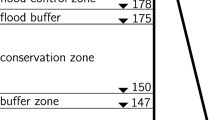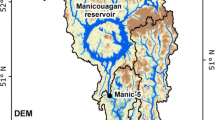Abstract
Increased reliance on variable and intermittent energy sources is likely to lead to a change in the production strategies of hydropower, thereby increasing the importance of accurate forecasting of production. For optimization models applied to water reservoirs, the computational cost increases with the number of reservoirs and future time-steps considered, often requiring simplification of the physical description of the flow dynamics. Here it is demonstrated that deficiency of the model of the flow dynamics on stream-reaches gives rise to errors in short-term planning, which leads to sub-optimal production. Here a simplified hydraulic model based on the kinematic-diffusion wave model was incorporated in the optimization of reservoir production planning. The time-lag distributions of the streams were evaluated for River Dalälven and implemented in a computationally efficient form of the kinematic-diffusion wave equation incorporated in a production optimization algorithm for a series of reservoirs. Compared to using a single time-lag for the water transfer on flow reaches between hydropower stations, the wave diffusion was found to affect the management as a deviation between the actual production and the planned production. The deviation was found to increase with increasing short-term regulation and decreasing Peclet number below about 10. For a sufficiently high Peclet number and long wavelength characterizing individual stream reaches, the distribution of time-lags become sufficiently narrow to motivate being replaced by a simpler description such as the constant time-lag.



Similar content being viewed by others
References
Akan AO, Yen BC (1981) Diffusion-wave flood routing in channel networks. J Hydraul Div 107:719–732
Arnold E, Tatjewski P, Wolochowicz P (1994) 2 methods for large-scale nonlinear optimization and their comparison on a case-study of hydropower optimization. J Optim Theory Appl 81:221–248. doi:10.1007/Bf02191662
Bazarra MS, Sherali HD, Shetty CM (1993) Nonlinear programming: theory and algorithms. Wiley, New York
Braga B, Barbosa PSF (2001) Multiobjective real-time reservoir operation with a network flow algorithm. J Am Water Resour Assoc 37:837–852. doi:10.1111/j.1752-1688.2001.tb05516.x
Diaz GE, Fontane DG (1989) Hydropower optimization Via sequential quadratic-programming. J Water Resour Plan Manag Asce 115:715–734
Labadie JW (2004) Optimal operation of multireservoir systems: state-of-the-art review. J Water Resour Plan Manag Asce 130:93–111. doi:10.1061/(Asce)0733-9496(2004)130:2(93)
Lindström G, Pers C, Rosberg J, Strömqvist J, Arheimer B (2010) Development and testing of the HYPE (hydrological predictions for the environment) water quality model for different spatial scales. Hydrol Res 41:295–319
Litrico X (2009) Modeling and Control of Hydrosystems. Springer
Litrico X, Fromion V (2004) Simplified modeling of irrigation canals for controller design. J Irrig Drain Eng Asce 130:373–383. doi:10.1061/(Asce)0733-9437(2004)130:5(373)
Litrico X, Georges D (1999) Robust continuous-time and discrete-time flow control of a dam-river system. (I) modelling. Appl Math Model 23:809–827. doi:10.1016/S0307-904x(99)00014-1
Montero RA, Schwanenberg D, Hatz M, Brinkmann M (2013) Simplified hydraulic modelling in model predictive control of flood mitigation measures along rivers. J App Water Eng Res 1:17–27. doi:10.1080/23249676.2013.827897
Moramarco T, Pandolfo C, Singh VP (2008) Accuracy of kinematic wave and diffusion wave approximations for flood routing. I: steady analysis. J Hydraul Eng 13:1078–1088. doi:10.1061/(Asce)1084-0699(2008)13:11(1078)
Morari M, Lee JH (1999) Model predictive control: past present and future. Comput Chem Eng 23:667–682
Pinho J, Ferreira R, Vieira L, Schwanenberg D (2015) Comparison between Two hydrodynamic models for flooding simulations at river lima basin. Water Resour Manag 29:431–444. doi:10.1007/s11269-014-0878-6
Qin SJ, Badgwell TA (2003) A survey of industrial model predictive control technology. Control Eng Pract 11:733–764
Rani D, Moreira MM (2009) Simulation–optimization modeling: a survey and potential application in reservoir systems operation. Water Resour Manag 24:1107–1138. doi:10.1007/s11269-009-9488-0
Schuurmans J, Hof A, Dijkstra S, Bosgra OH, Brouwer R (1999) Simple water level controller for irrigation and drainage canals. J Irrig Drain Eng Asce 125:189–195. doi:10.1061/(Asce)0733-9437(1999)125:4(189)
Schwanenberg D, van Breukelen A, Hummel S Data assimilation for supporting optimum control in large-scale river networks. In: Networking, Sensing and Control (ICNSC), 2011 I.E. International Conference on, 11–13 April 2011. pp 98–103. 10.1109/ICNSC.2011.5874881
Shim KC, Fontane DG, Labadie JW (2002) Spatial decision support system for integrated river basin flood control. J Water Resour Plan Manag Asce 128:190–201. doi:10.1061/(Asce)0733-9496
Singh VP (1996) Kinematic Wave Modeling in Water Resources: Surface-Water Hydrology. John Wiley & Sons, Inc.
Singh VP, Aravamuthan V (1995) Accuracy of kinematic wave and diffusion wave approximations for time-independent flows. Hydrol Process 9:755–782. doi:10.1002/hyp.3360090704
Souza TM, Diniz AL (2012) An Accurate Representation of Water Delay Times for Cascaded Reservoirs in Hydro Scheduling Problems 2012 Ieee Power and Energy Society General Meeting
Szymkiewicz R (2010) Numerical Modeling in Open Channel Hydraulics vol 83. 1 edn. Springer Science+Business Media. 10.1007/978-90-481-3674-2
Teegavarapu RSV, Simonovic SP (2000) Short-term operation model for coupled hydropower reservoirs. J Water Resour Plan Manag Asce 126:98–106. doi:10.1061/(Asce)0733-9496(2000)126:2(98)
Tsai CW (2003) Applicability of kinematic noninertia, and quasi-steady dynamic wave models to unsteady flow routing. J Hydraul Eng 129:613–627
Turgeon A (1981) Optimal short-term hydro scheduling from the principle of progressive optimality. Water Resour Res 17:481–486. doi:10.1029/Wr017i003p00481
Unver OI, Mays LW (1990) Model for real-time optimal flood control operation of a reservoir system. Water Resour Manag 4:21–46
Yoo J-H (2009) Maximization of hydropower generation through the application of a linear programming model. J Hydrol 376:182–187. doi:10.1016/j.jhydrol.2009.07.026
Acknowledgments
Funding for this investigation was provided by the Swedish Hydropower Centre (SVC), a center for education and research within hydropower and mining dams.
Author information
Authors and Affiliations
Corresponding author
Additional information
Key Points
•Operation planning is affected by streamflow wave diffusion
•Impact of time-lag description increases as operation planning time-scales decreases
•Impact of wave diffusion on planning decreases with Peclet number
Rights and permissions
About this article
Cite this article
Zmijewski, N., Bottacin-Busolin, A. & Wörman, A. Incorporating Hydrologic Routing into Reservoir Operation Models: Implications for Hydropower Production Planning. Water Resour Manage 30, 623–640 (2016). https://doi.org/10.1007/s11269-015-1181-x
Received:
Accepted:
Published:
Issue Date:
DOI: https://doi.org/10.1007/s11269-015-1181-x




